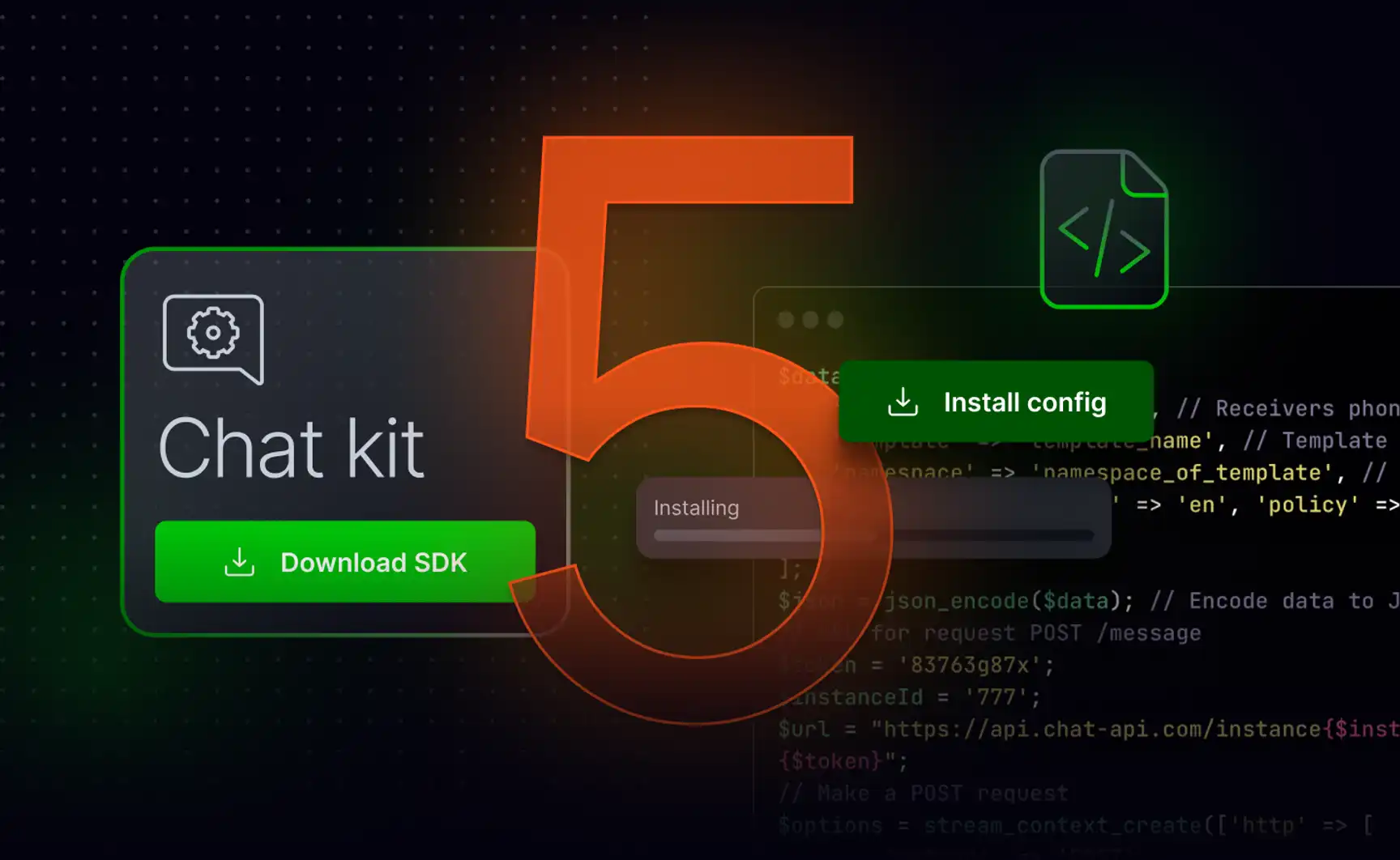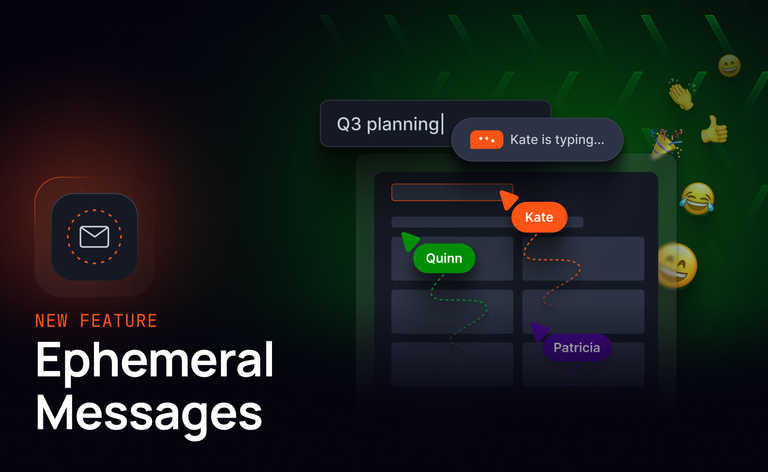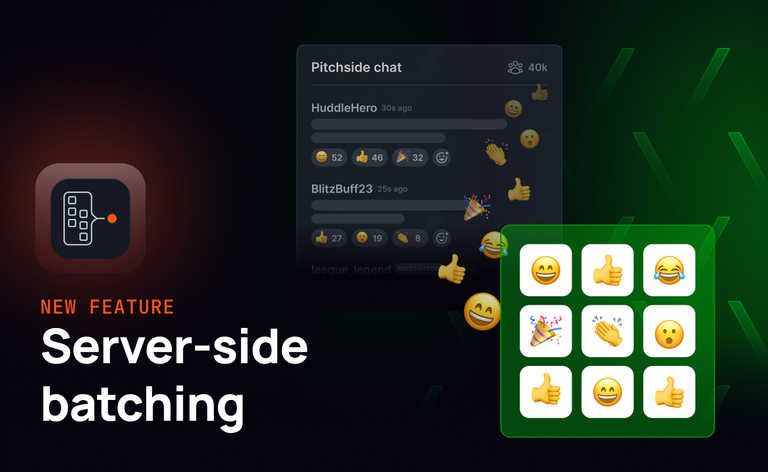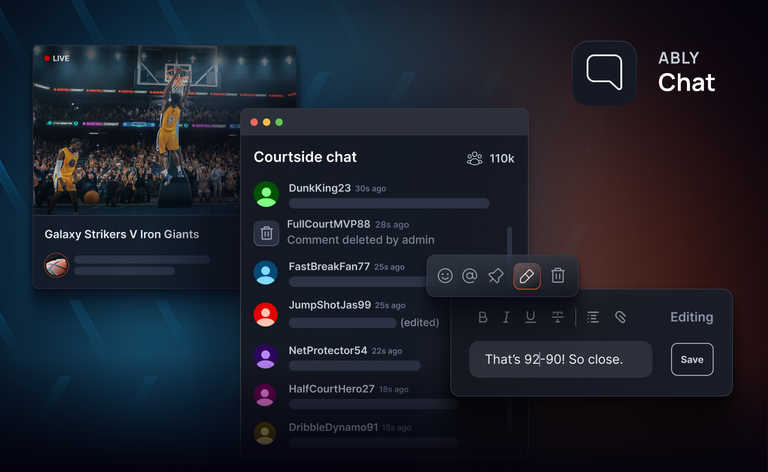Looking for the perfect realtime chat API can be a daunting task.
You need a provider that not only supports all the necessary chat features, but also offers delivery and scaling guarantees to ensure a smooth chat experience across web and mobile apps as your business grows.
While it might be tempting to start with a simple chat solution and see how your needs evolve, underestimating the importance of finding the best chat API provider can be a costly mistake. Switching solutions later requires significant time, resources, and money, not to mention meticulous testing to avoid disruption to your business, which can lead to reputational damage and lost revenue. You need to get it right the first time, and this post is here to help you do exactly that.
With so many chat and instant messaging APIs on the market, it's hard to know where to start. That's why we've narrowed it down to just the 5 best chat solutions - taking into consideration factors like features, scalability, and price. This way, you can make an informed decision about which provider will work best for your project.
What are chat APIs and SDKs?
Fundamentally, chat APIs and SDKs enable developers to build web and mobile applications that require chat more quickly by managing the infrastructure necessary to send and receive messages in realtime, whilst also offering must-have chat features like typing indicators, online indicators, and read receipts.
If you're wondering how a chat API and chat SDK differ in this context, it has to do with how developers interface with the chat app infrastructure.
A chat API gives developers direct access to the infrastructure through endpoints to send and receive messages, subscribe to typing indicators, and more. Equipped with the nuts and bolts, developers can now implement a chat UI with total flexibility.
A chat SDK, on the other hand, offers a complete set of chat app development tools, usually including prebuilt chat UI components. By assembling chat “building blocks”, developers can save time up front.
Remember that chat APIs and chat SDKs aren't mutually exclusive, and some providers offer both.
Looking for more on realtime APIs and how they work? Read our guide.
What should you look for in a live chat solution
Chat apps like WhatsApp and Slack have set the bar for live chat experiences, and it's important to find a chat platform that enables you to deliver the same quality experience. These are the ten foundational features you must be able to deliver using your chosen chat solution, and that you should consider during your chat API evaluation process.
- Low Latency: If messages take too long to send or load, users won’t have a smooth user experience and will take the conversation elsewhere. That could be another channel (for example, a customer might pick up the phone and start their support request from scratch) or, if the experience is consistently laggy, users might even switch to another app.
- Scalability: As your user volume grows, the load on the server also increases. If the server of your chat platform can’t handle this increased load, chat features can become unresponsive, causing a poor user experience in your mobile and web apps.
- Reliability: Even a short downtime or an occasional error can be frustrating for users. This is unfortunate, but for businesses that rely on chat or instant messaging apps for customer support or sales, downtime can result in lost revenue or missed opportunities.
- Guaranteed delivery: Messages should be delivered exactly once and in the correct order, even in the face of network issues. Otherwise, messages might come flying in out of order, and more than once, making it almost impossible to discern what is trying to be communicated.
- Elasticity: The number of users can be unpredictable for chat apps. Applications may experience sudden spikes in usage during peak hours or events, or during product launches and marketing campaigns. If the server of your chat platform can’t scale its resources up dynamically in response to changes in user demand, chat features may become unresponsive.
- Rich features: Your users will expect typing indicators, online status indicators, read receipts, push notifications, and more. If users can’t accomplish what they need to with your chat or in app messaging experience, they might switch to another app where they can. For a comprehensive guide to the features needed, see our ultimate list of live chat features (complete with examples).
- Integrations: Live chat solutions need to integrate with the other tools in your tech stack. Dedicated integrations between technologies can help keep engineering requirements to a minimum.
- Data governance: The way data is stored, processed, and disposed of needs to meet regulatory requirements, wherever you operate.
- Chat moderation: Chat experiences need to be safe for both end users and chat operators. The process of monitoring and controlling user-generated messages helps ensure compliance with your terms of use.
- Frontend UI: Customizable themed components including colors and fonts help to keep your chat solution a cohesive part of your customer experience.
Another key consideration when evaluating a live chat solution is, of course, cost.
Most chat or instant messaging API services base their pricing on the number of monthly active users (MAUs). Some also account for additional factors like the number of messages and the number of concurrent users.
While it might be hard to predict your precise usage up front, you should evaluate how a given provider’s pricing model might scale for your project. For example, some pricing models get gradually more expensive as you grow, while others hit an inflection point.

Now that we’ve covered the fundamentals of how to evaluate chat API services, let’s look at the five best chat APIs on the market.
The 5 best chat APIs and messaging SDKs
1. Ably - best for reliable realtime experiences, including chat
Ably is a realtime experience infrastructure provider used by companies like HubSpot, I7Live, and Riff to build fully-featured and reliable chat.
Our new product, Ably Chat, is designed to deliver a great chat experience for use cases from livestreams and in-game communication to customer support and social interactions in SaaS products.
It comes with purpose-built APIs for quickly building out chat features, including realtime messaging, online status and presence tracking, typing indicators, and room-level reactions.
Built on Ably's core platform, Ably Chat streamlines the complexities of realtime chat architecture, providing a powerful and flexible solution for a wide range of use cases. Here’s how it benefits you:
- Composable realtime: Unlike chat-specific products or building your own solution from scratch, Ably offers the best of both worlds - full flexibility to build what you want, and quickly.
- Dependable by design: We’ve built a realtime experience platform engineered for predictable latencies, ensuring uninterrupted service, capacity and availability across regional and global levels, even at extreme scale. In addition, with built-in message guarantees for ordering and exactly-once delivery, your data’s integrity is assured.
- Cost optimizations: Our flexible pricing model—offering customizations like per-minute billing, consumption-based pricing and volume discounts—is tailored for operations at scale. And soon, upcoming features like batching and aggregation will help keep costs low.
And because you're building on the Ably platform, you'll also benefit from low latency, guaranteed message ordering, and a 99.999% average uptime SLA.
2. Twilio - best for omni-channel communication features
Twilio is a communication platform with a suite of products designed to help developers code communication features like SMS, email, video, and - you guessed it - chat.
Their chat solution is called Conversations API and it's unique because it's specifically designed to act as an omni-channel messaging platform API.
Suppose your project revolves around connecting members from your team with customers. With Twilio's Conversations API, the customer can start a chat in-app then continue it on WhatsApp, for example. Twilio helps to connect the dots, creating a seamless omni-channel experience on both sides.
fAlthough the Conversations API could be adapted to enable your users to chat together (e.g. for group chat, like in-game chat), that isn't really the intended use case. As a result, Conversations API offers a limited chat feature set compared to some alternative solutions. For example, you can't use Twilio to implement public group chat, and they don't support @user and @channel mentions or reactions.
3. Firebase - best for existing Firebase users looking to add chat
Firebase is an app development platform backed by Google that famously replaces the need for a backend. It accomplishes this by providing developers with a variety of services, including authentication, push notifications, and a database called Cloud Firestore that can be adapted to store and broadcast chat messages in realtime.
Firebase can be an attractive messaging solution because it manages all of your backend services in one place. These services are designed to gel well together, so it should be smooth to implement user management, roles and permissions, chat history, and even push notifications under the roof of one platform.
Of course, this might not be so compelling if you already have a backend and user management system. In that case, you'll probably want to assess how you'll keep Firebase and your systems in sync instead.
It is also worth noting that since Firebase is a general-purpose platform, it doesn't have a specific notion of chat. While implementing basic chat features might be fairly straightforward, expect to invest a significant amount of upfront development to get features like typing indicators, read receipts, and presence indicators to work, especially without a hitch at scale.
4. Sendbird - best for a quick, out-of-the-box chat SDK
Sendbird Chat enables developers to integrate chat by providing an chat SDK with ready-made chat UI components. They cover all the essential features you might expect, including voice and video, which makes it possible to deliver a comprehensive chat experience.
This out-of-the-box experience chat SDK enables developers to “turn on” chat quickly, albeit at a recurring monthly premium. A common concern about Sendbird is that, beyond a certain scale, their pricing becomes somewhat opaque. This can make it hard to calculate precisely how much you'll pay for your messaging solution, especially if you're dealing with a high number of users and traffic spikes.
Under the hood, Sendbird manages the chat infrastructure necessary to send and receive messages in realtime while ensuring that messages are stored securely and compliant with relevant standards like SOC 2 and HIPAA.
It should be noted that although Sendbird touts eight available data centers, each app must reside in a single data center, creating a single point of failure. Moreover, this can negatively impact latency, unless your users happen to be connecting from the same geographical region.
5. Stream (formerly GetStream) - best for a chat API + UI kit offering
Stream provides chat APIs and UI components that developers can use to integrate live chat into their web and mobile applications.
They make it possible to build chat experiences with rich features like typing indicators, user presence, threaded conversations, push notifications, message & user moderation, reactions, plus @user and @channel mentions. In other words, everything you would expect from a modern chat app.
All the chat infrastructure is managed for you. However, all chat traffic is processed and stored in a single data center. This can have a negative implication on latency and creates a single point of congestion and failure. This might explain why Stream only offers a 99.95% SLA - unless you pay more for an enterprise plan.
It's worth noting that chat often goes hand-in-hand with other realtime use cases, such as multiplayer collaboration (think of a product like Figma, where you can edit your design collaboratively and chat with other users in realtime). However, Stream is very much a chat-centric solution. If you're looking to build other realtime experiences alongside chat, Stream can't help – you will have to use different technologies, which brings additional complexity and increased costs to your project.
Which is the best chat solution for your use case?
Like everything in software, the answer is “it depends” - on the realtime and chat features you need, how you envision your users engaging with your web apps and mobile apps, and on if you want to save time up front with a turn key solution at the cost of flexibility later. It's critical to try and answer these questions early on so you don't end up locked-in with a vendor (as you might with Firebase), or with a solution that is great for a chat app but forces you to source another solution to implement other realtime features like presence indicators, multiplayer collaboration (a la Figma), collaborative whiteboarding, and collaborative text editing.
Although we might be biased, if you are looking for a solution that can support you now - as you integrate chat - and as you scale, and introduce new features, we recommend trying Ably for free (no credit card required). Our free plan includes:
- 6M monthly messages
- 200 peak concurrent channels
- 200 peak concurrent connections
As a realtime Platform as a Service (PaaS), Ably gives you the infrastructure and tooling to build featureful in-app chat with no scale ceiling, low latency, predictable pricing, and 99.999% SLA. The best part? A new realtime feature doesn't require you to rebuild your entire back end or code against a brand-new API.
Whether it's a fundamental shift in how your product works, such as implementing multiplayer collaboration, or you want to enhance the experience through a feature such as in-app messaging, Ably makes it easy to get started thanks to integrations with almost every popular programming language and a free developer account.




